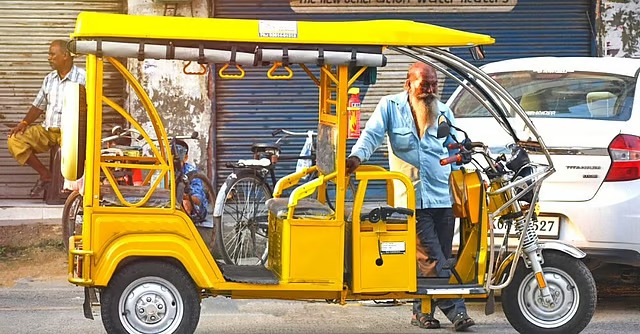@JUDGMENTTAG-ORDER
1. The Petitioner is Plaintiff in O.S. No. 661 of 2008 on the file of the Principal District Munsif Court, Namakkal. He is a tenant in the suit property and the first and second Defendants are the owners of the property. One Palanisamy, husband of the first Respondent and the first and second Respondents took lease of suit property from the Petitioner in the year 1984. The said Thangaraj died. The Petitioner filed the above said suit for relief of permanent injunction restraining the Defendants from evicting them without due process of law and the same is pending.
2. Pending the trial of the suit, the Petitioner filed an application under Order 1 Rule 10 and Section 151 of CPC to implead the 3 & 4th Respondents as the Defendants to the suit. In the affidavit, he has alleged that the Bank, the proposed party has recorded symbolic possession and admitted the property to public auction and the other proposed party is the authority to act under the provision of SERFAESI Act (hereinafter referred to as ''Act'').
3. This Petitioner has no objection in permitting the Bank to record the symbolic possession to bring the property to public auction and the successful bidders to take possession of the property. However, for final adjudication of the case, the proposed party may be added as Defendants.
4. In the counter filed by the Defendants, it is stated that the proposed parties are entitled to take action under the provisions of the Act, that Section 34 of the Act put a prohibition on the Civil Court to deal with any matter which are within the purview of the Act, that the request of the Petitioner is unreasonable and there is no necessity to implead the proposed parties as Defendants in the suit.
5. After hearing both sides, the learned District Munsif has dismissed the application accepting the contentions of the proposed parties and the Defendants. Hence, the Petitioner is before this Court with this revision.
6. The learned Counsel for the Petitioner would submit that the Plaintiff in the suit is dominus litis, that he is competent to decide who are to be impleaded as parties to the suit, that in order to finally adjudicate the matter in the presence of the proposed parties, their presence is very much essential and that the Respondents would not be prejudiced in this regard.
7. In support of his contention ,he garnered support from a decision of Supreme Court reported in 2010 (5) CTC 354 [Mumbai International Airport Pvt. Ltd. v. Regency Convention Centre & Hotels Pvt. Ltd. and Ors.] in which Their Lordships have dealt with the provision in Order 1, Rule 10 of CPC and formulated principles with regard to proper party and necessary party to be impleaded in a suit and the consequences thereof for the non-impleadment. The following is the relevant portion of the judgment of the Supreme Court after extracting Order 1 Rule 10(2) of Code of Civil Procedure.
The said provision makes it clear that a Court may, at any stage of the proceedings (including Suits for specific performance), either upon or even without any Application, and on such terms as may appear to it to be just, direct who ought to have been joined as Plaintiff or Defendant, but nor added; or (b) any person whose presence before the Court may be necessary in order to enable the Court to effectively and completely adjudicate upon and settle the question involved in the Suit. In short, the Court is given the discretion to add as a party, any person who is found to be a necessary party or proper party. A ''necessary party'' is a person who ought to have been joined as a party and in whose absence no effective decree could be passed at all by the Court. If a ''necessary party'' is a party who, though not a necessary party, is a person whose presence would enable the Court to completely, effectively and adequately adjudicate upon all matters in disputes in the Suit, though he need not be a person in favour of or against whom the decree is to be made. If a person is not found to be a proper or necessary party, the Court has no jurisdiction to implead him, against the wishes of the Plaintiff. The fact that a person is likely to secure a right/interest in a suit property, after the Suit is decided against the Plaintiff, will not make such person a necessary party or a proper party to the Suit for specific performance.
8. Conversely, the learned Counsel for the proposed parties/3rd and 4th Respondents would contend that the Act is a special Act which empowers the authorities concerned to take suo moto action in the matter of loans advanced by the Defendants to the public, that the Civil Court has no jurisdiction to entertain any suit which touches the provisions of the Act and that the Act is having over riding effect upon the general law. In support of his contention, he placed reliance upon a decision of Division Bench of this Court reported in
9. On a plain reading of the observations made in Transcore case, it is clear that the Bank/FI is entitled to take actual possession of the secured assets from the borrower or from any other person in terms of Section 13(4) of the SARFAESI Act. Any transfer of secured assets after taking possession of the same by the Bank/FI shall vest in the transferee all rights in relation to the secured assets as if the transfer has been made by the owner of such secured assets. Any party aggrieved by such dispossession will have to take recourse to approaching the DRT u/s 17(4) of the SARFAESI Act. If the party is dispossessed, not in accordance with the provisions of the Act, then the DRT is entitled to put the clock back by restoring the status quo ante. By virtue of Section 17(4) read with Section 35 of the SARFAESI Act, if in a given case the measures undertaken by the secured creditor u/s 13(4) come in conflict with the provisions of any State law, then notwithstanding to such conflict, the provisions of Section 13(4) shall override the local law. Section 13(13) of the SARFAESI Act operates as an attachment/injunction restraining the borrower from disposing of the secured assets and therefore, any tenancy created after such notice would be null and void. Any tenancy created by the mortgagor after the mortgage in contravention of Section 65-A would not be binding on the bank/FI, and in any event such tenancy rights shall stand determined once action u/s 13(4) has been taken by the Bank/FI. When the Petitioner is claiming a tenancy prior to the creation of mortgage such tenancy is disputed by the bank the remedy of the Petitioner is to approach DRT by way of an application u/s 17 of the SARFAESI Act to establish its rights.
9. Section 34 of the Act excludes the jurisdiction of the Civil Court. It puts an embargo on the power of the Civil Court to entertain any suit or proceedings with respect to any matter which lower appellate tribunal or appellate tribunal is empowered to do. Further, the Act being a special Act specifically provides u/s 35 that the Act will over ride all other laws which are in force. Sections 34 and 35 of the Act go thus:
34. Act to have over riding effect.- (1) Save as provided under Sub-section (2), the provisions of this Act shall have effect notwithstanding anything inconsistent therewith contained in any other law for the time being in force or in any instrument having effect by virtue of any law other than this Act.
(2) The provisions of this Act or the rules made thereunder shall be in addition to, and not in derogation of, the Industrial Finance Corporation Act, 1948 (15 of 1948), the State Financial Corporations Act, 1951 (63 of 1951), the Unit Trust of India Act, 1963 (52 of 1963), the Industrial Reconstruction Bank of India Act, 1984 (62 of 1984), [the Sick Industrial Companies (Special Provisions) Act, 1985 (1 of 1986) and the Small Industries Development Bank of India Act, 1989 (39 of 1989)].
35. Power to remove difficulties.- (1) If any difficulty arises in giving effect to the provisions of this Act, the Central Government may, by order published in the Official Gazette make such provisions, not inconsistent with the provisions of this Act, as appear to it to be necessary or expedient for removing the difficulty:
Provided that no such order shall be made after the expiry of the period of three years from the date of commencement of this Act.
(2) Every order made under this section shall, as soon as may be after it is made, be laid before each House of Parliament.
10. The learned Counsel for the Respondents 3 and 4 further cites a Division Bench decision of the Kerala High Court reported in AIR 2007 Kerala 114 in which an observation has been rendered u/s 35 of the Act to the effect that the provisions of the Act have got over riding effect over the Kerala Buildings (Lease and Rent Control) Act and parties are governed by the Act and not by the Rent Control Act.
11. He also submits that the suit was filed on 25.11.2008 and the notice u/s 132(2) was issued on 18.02.2008 as per Ex.R1 to the parties concerned. The Collector, thereafter passed proceedings on 14.02.2009. The above said instances would go to show that possession of the property was taken by the Bank through the authorities prescribed under the Act. The interlocutory application was filed on 20.04.2009 subsequent to taking of possession.
12. In view of the above said decisions, this Court is of the considered view that the proposed parties need not be impleaded in the suit. The reason being that whatever be the grievance of the Petitioner against the Bank has to be addressed before the competent forum as per the settled law. The Civil Court has no jurisdiction to entertain any proceedings which touches the procedures contained in Act and that the Act has got over riding effect over other existing laws. Hence, this Court does not find any infirmity legally or factually which deserves to be confirmed and it is accordingly confirmed. The Civil Revision Petition is devoid of merits.
13. In the result, the Civil Revision Petition is dismissed. No costs. Consequently, connected Miscellaneous Petition is closed.

